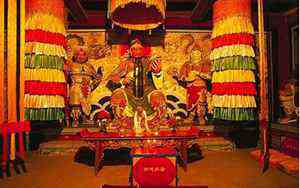
分享:《熄灯后请不要翻牌》大秘仪 英文原版+翻译(2女教皇)
塔罗占卜,并不是算命,也不是去预测结果,塔罗是以心理学为基础,借助塔罗牌中种种意项,把你内心和对于未来的种种预想显示出来。是一种解读自己内心的方法。告诉你,在目前的状况、想法和做法下,事情会发展到什么状态,想要不一样的结果,你得采取什么行动。至于你是否按塔罗的提示去行动,由你掌握。
书名:《The Secrets of the Tarot——Origins, History, and Symbolism》
作者: Barbara G. Walker
出版社: Harper San Francisco
出版年: 1984-10
台版译后名字《熄灯后请不要翻牌》
这是一本绝版图书,大量神话、宗教和语言学的内容,不会教你塔罗的使用方法,也比较晦涩难懂,可以作为看待塔罗的新视角。此次也只分享大密仪的相关内容,喜欢的可以读读。
英文文字版图书由妙翊塔罗提供。(因不同人对同一事物持有不同看法,为了严谨,增加英文文字版。翻译必定会有歧义,个人翻译原因有少许出入,不影响阅读)。
( 诺斯替教是基督教异端派别。诺斯替教派(Gnosticism)亦译“灵智派”、“神知派”。罗马帝国时期在地中海东部沿岸各地流行的许多神秘主义教派的统称。2-3世纪从古代诺斯替教演变而成。其主要代表是撒土尼罗、巴西理得。“瓦伦廷诺斯替”一词的本义是真知即神秘的超自然的知识或智慧,认为通过这种智慧就可以了解宇宙,把人从物质世界中拯救出来。其思想来源于巴比伦的宗教神秘观念,波斯宗教的善与恶、精神与物质的二元论,万物从神流溢出来的新柏拉图主义。该派把精神世界看成善的,身体看成恶的,身体是囚禁人生的监狱,只有消灭肉体才可以得到解脱。认为最高神的本质是心灵、生命和光,物质世界不是至上神所造,而是由低于至上神的“巨匠造物主”所造。与物质世界相平行,存在一个真实的精神世界。——朱贻庭.伦理学大辞典:上海辞书出版社,2010)
本书认为塔罗实际上主要受到诺斯替教等异教的影响而产生,而非基督教。并通过大量文献及圣经内容,力证基督教本身许多教义及仪式也是一种从异教身上的拿来主义,最终将诸多异教内容及仪式基督化,变成基督教义与仪式。
2. 女教皇
2. The Papess
The Papess was perhaps the least acceptable Tarot figure to the Christian establishment, since the latter was dedicated to the idea that ecclesiastical authority was for men only. Clerical pressure forced French card painters to change the Papess to the Goddess Juno in eighteenth-century packs. A Belgian pack even changed her into a man, called the Spaniard. Modern packs euphemize her title as “the High Priestess.” Christian orthodoxy insisted that there never was, and never could be, a female pope. But other traditions suggested a different opinion.
Gnostics preserved some Gospels that were eliminated from the orthodox canon early in the Christian era. These texts said the first “pope” was not St. Peter, but St. Mary Magdalene, who received spiritual authority directly from Jesus after the Oriental custom of cross-sexual transmission—male to female, or vice versa. Jesus loved Mary Magdalene above all his other followers; he called her Apostle to the Apostles, and the Woman Who Knew the All. He said she would rule all other disciples in his future Kingdom of Light. “There was no grace that He refused her, nor any mark of affection that He withheld from her.” He gave to her, not to Peter, the power of the keys of heaven. Peter angrily tried to force the secret from her. The Gospel of Mary said Levi had to rebuke Peter for his violent attack on Mary. In the Pistis Sophia, Mary said, “Peter makes me hesitate; I am afraid of him, because he hates the female race.”
Some early Christian fathers recognized a spiritual authority vested in Mary Magdalene, which was erased by later church historians, who decided she was a simple harlot. Origen said she was, on the contrary, “the mother of all of us,” as a male pope was supposed to be a spiritual father to the whole flock. Origen gave Mary Magdalene the title of Ecclesia, “the Church,” which was applied to the Virgin Mary as well. He identified Mary Magdalene with the Great Goddess, by saying she had lived since the beginning of time, and was immortal.
Many believed him. Mary’s fame waxed. During the seventh century, an old Roman temple of the Goddess was renamed Santa Maria Maggiore, and dedicated to Mary Magdalene as the foundress of women’s ecclesiastical orders, especially teaching orders, and the combined male-and-female “double monasteries” that flourished before the tenth century.
In a way, Magdalenian teaching nuns continued the Roman tradition of the collegia, a temple of teaching priestesses with the title of alma mater, “soul-mother.” The derivation was from Al-Mah, oldest Indo-Iranian name of Mother Moon. 8 A Hebrew cognate, almah, meant moon-soul embodied in a young woman. This was the term for the Virgin Mary in Hebrew versions of the Gospels. Christians translated almah as “virgin,” but that was not its meaning. 9 As with the Roman “female soul,” alma, there was an implication of a holy woman linked with the moon, as a spiritual leader. Plutarch said the moon was the source of all “reason and wisdom.”
On Gnostic gems, Luna Regia (Queen Moon) appeared in the same dress and pose as the Tarot Papess, sitting before the same temple veil, wearing a papal tiara decorated with a crescent moon. A fourteenth-century manuscript showed the same Goddess as a papess, abbess, or nun. 12 Significantly, the Tarot Papess was numerically linked with the card of the Moon (Trump #18), and also with the concept of teaching, symbolized by the book in her hand.
Official church histories tried to hide the fact that even within Christianity, the pagan tradition of feminine spiritual authority remained strong up to the thirteenth century, when monks began to encroach on the educational convents ruled by supreme abbesses, who were formerly ordained like bishops. Abbesses’ older titles included Matris Spirituale (Spiritual Mother), Sacerdos Maxima (High Priestess), and Matriarch. They had political and economic autonomy, ruling male as well as female clergy.
Certain orders of nuns were famed as educators, until the Council of Trent ruled that women’s orders must relinquish their property to men’s orders, and no more teaching convents were allowed. Theological studies of the Beguines, for example, were forbidden. The women were forced to give up their houses and lands, which were taken over by the Inquisition. Nuns were obliged to integrate into orders approved by the pope, where they would remain secluded, and uneducated.
Church histories were often edited to eliminate references to women in the higher ecclesiastical ranks. Yet up to the sixteenth century, even church historians were firmly convinced that there had been at least one real papess, popularly known as Pope Joan, whose profound learning earned her the rank of cardinal, then of pope. The Tarot Papess was sometimes called Joan also; she wore the same tiara shown on Pope Joan’s head in old engravings. 16 Pope Joan’s likeness appeared in the row of papal busts in Siena Cathedral, labeled Johannes VIII, femina ex Anglia: Pope John VIII, an Englishwoman. 17 The first recorder of Pope Joan’s pontificate was her contemporary, Anastasius the Librarian (d. 886). Scotus’s chronicle of the popes said: “ A.D. 854, Lotharii 14, Joanna, a woman, succeeded Leo, and reigned two years, five months, and four days.” De Gemblours’s tenth-century chronicle said, “It is reported that this John was a female, and that she conceived by one of her servants. The Pope, becoming pregnant, gave birth to a child, wherefor some do not number her among the Pontiffs.” The reason given for striking her from the record was not that she was nonhistorical, but that she was a mother. Thomas de Elmham’s official list of the popes in 1422 gave a similar reason: “ A.D.855, Joannes. This one doesn’t count; she was a woman.”
The papal historian and Vatican librarian PLatina wrote in The Lives of the Popes that Joan was English, and more learned in the Scriptures than any man. She disguised herself in men’s clothes. Her deception was revealed when her labor pains came on her. She died in a certain street between the Lateran Palace and St. Clement’s Church. 19 Martin Polonus said she was buried in the same street, which papal processions ever afterward avoided by a detour, “out of detestation for what happened there. Nor on that account is she placed in the catalogue of Holy Pontiffs, not only on account of her sex, but also because of the horribleness of the circumstances.” 20 The “horribleness” was that when her sex was discovered, she was dragged into the street and stoned to death, and buried on the spot in an unmarked grave. The real reason for subsequent popes’ avoidance of the street seems to have been superstitious fear of Joan’s vengeful ghost.
The period of Joan’s pontificate was the only one ever stricken from the record, though it was better documented than many of the early popes, some of whom were only names, invented and inserted centuries after their alleged reigns. The church now claims that Pope Joan was entirely legendary. The most it will admit is that there was an “antipope” named John (Joannes) about this time, enthroned by popular demand against the will of the Curia.
In 1886 a Greek writer, Emmanuel Royidis, published the biography of Papissa Joanna, saying “Every sentence in my book and almost every phrase is based on the testimony of contemporary authors.” The church immediately banned his book and excommunicated him.
Whether Pope Joan was legendary or not, a strange Vatican custom appeared after what the church insisted was not her reign. Candidates for the papacy seated themselves naked on an open stool, like a toilet seat, to be viewed through a hole in the floor by cardinals in a room below. The committee then had to render a formal verdict: Testiculos habet, et bene pendentes—“He has testicles, and they hang all right.”
The notion of a female pope persisted despite every precaution. Some of the Gnostic sects, who admitted women to ecclesiastical rank on an equal basis with men, held that only a female pope could counteract the abuses of the cynical, greedy Renaissance papacy. One such sect, the Guglielmites of Lombardy, elected their own papess to serve as the successor of their own saint, Guglielma of Bohemia, who died in Milan in 1281. The sectaries believed that Guglielma was the incarnation of the Holy Ghost, and would return to earth in a Second Coming at the Feast of Pentecost in the year 1300, whereupon the male-dominated church would wither away, and a better Christianity would rise under
a line of female popes. The first of these, Manfreda, was placed in office by the sectaries. Wealthy Lombard families provided costly sacred vessels for her first Mass, supposed to take place in Rome at the Church of Santa Maria Maggiore. Because the followers of Papess Manfreda began to grow to really threatening numbers, and to demonstrate an enthusiasm that the incumbent papacy thought dangerous, the sect was exterminated by the Inquisition and the unlucky female pope was burned at the stake.
More than these footnotes to history helped create the Tarot Papess, a fixture of the Major Arcana from its beginning. The Papess was also known as the Wise Woman, or Sophia—Greek for “female wisdom”. This was the former name of the Holy Spirit in its (her) original female form, as the spouse or Shakti (Power) of God. One of her emanations was the alchemical Mother of Wisdom—Sophia in Greek, Sapientia in Latin. Identified with the moon in alchemical texts, she bluntly told the male deity: “Thou dost nothing alone if I am not present with my strength, as a cock is helpless without a hen.”
Some medieval mystics presented her as a wholly female trinity: Sapientia creans, the creatress; Sapientia disponans, who unified all things in harmony; and Sapientia gubernans, the Governess, “otherwise known as Divine Providence.” She was called “the basic and primordial foundation of all things … the being, life, and light of intelligible things,” equal and commensurate with the Divine Essence. Spenser defined her as Queen of Heaven, “sovereign darling of the Deity,” and Spouse of God, who sat enthroned in his bosom “clad like a Queen in royal robes.”
To the Gnostics, Hagia Sophia (Holy Sophia) was the Great Mother. She gave birth to Jehovah, who became the jealous God of Eden, forbidding humans to obtain the knowledge they needed. To undo this harm, Sophia gave birth to the spirit of Christ, and sent him to earth in the human body of Jesus. After Jesus’s death, Sophia and Christ made him a Hermes-like Conductor of Souls in heaven. Some of the Gnostics said Jesus married a Virgin of Light, Sophia’s emanation, much as the pagan savior Heracles married the Virgin Hebe, an emanation of the Mother Goddess, Hera. 29 The early Christian father Irenaeus declared that Sophia also gave birth to all the angels.
In honor of this Gnostic Goddess, the great church of Hagia Sophia was built in Constantinople during the sixth century. Christian authorities now deny that this church was ever dedicated to any form of the Great Mother. They pretend the name Hagia Sophia really meant “Christ, the Word of God.” 31 It is difficult to see how “Christ, the Word of God” can be made out of a name that means, in plain Greek, “Holy Female Wisdom.”
Another emanation of Sophia was Christianized as a fictitious virgin martyr, who, despite her virginity, had produced three daughters: St. Faith, St. Hope, and St. Charity. Credulous hagiographers took these legends seriously, though they obviously were no more than an allegorical statement that Wisdom gives birth to Faith, Hope, and Charity. The physical beauty of St. Faith was much praised, and a crypt was dedicated to her in St. Paul’s Cathedral in London. 32 There was also a pagan “St. Faith,” one of Aphrodite’s three lawgiving Charites. She was an ancient Roman Goddess named Bona Fides, “Good Faith “She was served by three senior flamines, the oldest core of Rome’s official clergy.
Thus it seems the Tarot’s first teacher, to whose presence the Magician conducted the know-nothing Fool, was the very spirit of Female Wisdom, without whom not even God could act. It was typical of Gnostic reasoning that her spirit should be embodied in a Papess. The position of the Papess corresponded to the third figure on the Tantric Wheel of Life, called Vijnana, the stage of development of conscious experience through teaching. 34 One of the first lessons taught the sadhaka was that no god could wield any power without his female “Wisdom,” an emanation of the Great Shakti (Kali). The same lesson apparently belonged to the secret Gnostic tradition.
参考译文:
女教皇可能是最不被基督教团体接受的塔罗牌人物,因为后者致力于教会权威只属于男人的理念。神职人员的压力迫使法国卡牌画家在十八世纪的卡牌资料中将“女教皇”改成了“朱诺女神”(Goddess Juno)。一个比利时族群甚至把她变成了一个男人,叫做西班牙人。现代族群委婉地称她为“女祭司”。基督教正统派坚持认为从来没有,也不可能有女教皇。但其他传统提出了不同的观点。
诺斯替主义者保存了一些福音书,这些福音书在基督教时代早期就被从正统正典中淘汰了。这些文本说,第一位“教皇”不是圣彼得(St. Peter),而是抹大拉的圣玛丽(St. Mary Magdalene),她按照东方的跨性别传播习俗——男性传给女性,或女性传给男性——直接从耶稣那里获得了精神权威。耶稣爱抹大拉的圣玛丽(St. Mary Magdalene)胜过他所有的追随者;他说她将在他未来光明的国度里统治其他所有的门徒。“他没有拒绝她的恩典,也没有拒绝她的任何慈爱。耶稣把天上的钥匙给了她,却没有给彼得。彼得生气地想强迫她保守秘密。《马利亚福音》说,列维必须斥责彼得对玛丽的猛烈攻击。在《Pistis Sophia》中,玛丽说:“彼得让我犹豫;我害怕他,因为他讨厌女性种族“。
一些早期的基督教神父认为抹大拉的玛利亚拥有精神上的权威,但后来的教会历史学家抹去了这一点,认为她只是个妓女。与此相反,奥利金(Origen(基督教神学家))说她是“我们所有人的母亲”,因为一位男性教皇理应是整个教众的精神之父。奥利金给抹大拉的玛利亚取名为“教会”,这也适用于圣母玛利亚。他认为抹大拉的玛利亚是伟大的女神,因为她从创世之初就活着,而且是不朽的。
有许多人信他。玛丽的名声渐渐变大。在七世纪,一座供奉女神的古罗马神庙被重新命名为圣玛丽亚·马乔里,并献给抹大拉的玛丽·玛格莱娜,她是女性教会修道会(尤其是教学修道会)的创始人,也是男女结合的“双修道院”的创始人,这种修道院在十世纪前十分繁荣。
在某种程度上,抹大拉教导的修女延续了罗马collegia的传统,这是一个以母校(alma mater)“灵魂之母”(soul -mother)的称号教导女祭司的寺庙。月亮的起源是Al-Mah,月亮母亲的最古老的印第伊朗语名字。一个希伯来语同源词almah,意思是年轻女子身上月亮的灵魂。在希伯来语版本的福音书中,这是对圣母玛利亚的称呼。基督徒将almah翻译为“童贞”,但这并不是它的意思与罗马的“女性灵魂”alma一样,它也有与月亮相连的神圣女性作为精神领袖的含义。普鲁塔克(Plutarch(希腊历史学家))说,月亮是一切“理性和智慧”的源泉。
在诺斯替的宝石上,月亮皇后(Luna regia)穿着同样的衣服,摆出塔罗牌女教皇的姿势,坐在同样的神庙面纱前,戴着装饰着新月的教皇头冠。一份14世纪的手稿显示了与教皇、女修道院院长或修女相同的女神。值得注意的是,塔罗牌女教皇的数字与月亮牌(特朗普18号)联系在一起,也与教学的概念联系在一起,这是她手里的书所象征的。
官方教会历史试图掩盖这样一个事实,即即使在基督教内部,女性精神权威的异教徒传统一直持续到13世纪,当僧侣们开始侵犯由最高院长统治的受教育的修道院时,这些院长以前被任命为主教。女修道院院长较老的头衔包括女修道院院长(精神母亲),女修道院院长(高级女祭司)和女修道院院长。他们有政治和经济自主权,统治着男女神职人员。
某些修女的修道会以教育工作者而闻名,直到特伦特委员会规定女性修道会必须将她们的财产让与男性修道会,不再允许有教学性质的修道院。例如,对贝京人的神学研究就被禁止了。妇女们被迫放弃被宗教法庭接管的房屋和土地。修女必须加入教皇批准的命令,在那里她们将保持封闭和不受教育。
教会历史经常被编辑,以消除在更高的教会级别中提到女性。然而,直到16世纪,甚至教会历史学家都坚信,至少有一位真正的教皇,即众所周知的教皇琼恩(Pope Joan),她的渊博学识为她赢得了枢机主教的头衔,然后是教皇。塔罗牌上的女教皇有时也被称为琼;她戴着旧雕刻中教皇琼恩(Pope Joan)头上的头饰。在锡耶纳大教堂,教皇琼的肖像出现在一排教皇半身像中,标为约翰内斯八世(女性前盎格鲁:英国女性教皇约翰八世)。
教宗贞德的第一位记录者是与她同时代的图书管理员阿纳斯塔修斯(公元886年)。司各脱(Scotus)的教皇编年史写道:“公元一个名叫乔安娜(Joanna)的妇人接续利奥(Leo)作王,在位二年零五个月零四天。德·杰布洛尔在十世纪的编年史中写道:“据报道,这个约翰(John )是个女人,是她的一个仆人怀上的。教皇怀了孕,生了一个孩子,有人不把她算在教皇之列"。把她从记录中删掉的原因不是因为她没有历史,而是因为她是一位母亲。托马斯·德·埃尔姆(Thomas de Elmham)在1422年的教皇官方名单中也给出了类似的原因:“公元855年,乔安。这个不算;她是个女人。”
教皇历史学家、梵蒂冈图书管理员普拉蒂娜在《教皇生平》中写道,琼(Joan)是英国人,比任何人都更精通圣经。她穿上男装伪装自己。她临产阵痛时,骗局被揭穿了。她死在拉特兰宫和圣克莱门特教堂之间的一条街上。马丁·波洛努斯(Martin Polonus )说,她就葬在这条街上,后来教皇的游行队伍为了避免走这条街,“出于对那里发生的事情的厌恶”。也不是因为这个原因,她被列入教皇名录,不仅是因为她的性别,还因为当时的环境很可怕。“可怕的”是,当她的性别被发现时,她被拖到街上,用石头打死,然后就地埋葬在一个没有标记的坟墓里。后来的教皇们不愿上街的真正原因似乎是出于对琼(Joan)的复仇鬼魂的迷信恐惧。
贞德担任教皇的时期是唯一被从记录中删除的时期,尽管它比许多早期教皇有更好的记载,其中一些教皇只是在他们声称的统治之后的几个世纪被发明并插入的名字。教会现在宣称教皇琼(Joan)是一个完全的传奇人物。它最多会承认的是,大约在这个时候,有一个名叫约翰(乔安妮)的“反教皇”,他在民众的要求下,违背了教廷的意愿,登上了教皇的宝座。
1886年,希腊作家伊曼纽尔·罗伊迪斯(Emmanuel Royidis)出版了帕皮萨·乔安娜(Papissa Joanna)的传记,他说:“我书中的每句话和几乎每句话都是基于当代作家的证词。”教会立即禁止了他的书,并将他逐出教会。
不管教宗贞德是否具有传奇色彩,在教会坚持认为不是她的统治之后,梵蒂冈出现了一个奇怪的习俗。教皇候选人赤身裸体地坐在一个像马桶座一样的开放式凳子上,下面房间里的红衣主教们可以通过地板上的一个洞看到他们。然后,委员会不得不作出正式的裁决:“他有睾丸,而且它们吊得很好。”
尽管采取了各种预防措施,但女性教皇的观念依然存在。一些诺斯替派(Gnostic)承认女性在教会的地位上与男性平等,他们认为只有一位女性教皇才能抵消文艺复兴时期愤世嫉俗、贪婪的教皇权力的滥用。伦巴第的古列尔派(guglielmites of Lombardy)就是这样一个教派,他们选举自己的教皇作为他们自己的圣人——1281年在米兰去世的波希米亚古列尔玛(Guglielma of Bohemia)的继承人。宗教派别认为,古格列尔玛是圣灵的化身,会在公元1300年的五旬节(Feast of Pentecost)的第二次降临时回归人间,届时男性主导的教会将会消亡,一个更好的基督教将在女性教皇的领导下崛起。其中的第一个,曼弗雷达(Manfreda),是由各教派任命的。富有的伦巴第家族为她的第一次弥撒提供了昂贵的圣器,弥撒原定在罗马的圣玛丽亚马乔里教堂举行。由于曼弗雷达(Manfreda)教皇的追随者开始增长到真正具有威胁性的数量,并表现出被现任教皇视为危险的热情,该教派被宗教裁判所消灭,那位不幸的女教皇被绑在火刑柱上烧死。
不仅仅是这些对历史的注脚帮助创造了塔罗牌女教皇(the Tarot Papess),从一开始就是大阿卡纳的固定工具。女教皇也被称为“智慧的女人”,或者索菲亚——希腊语中的“女性智慧”的意思。这是圣灵在其(她)原始女性形态中的前身,作为上帝的配偶或Shakti(力量)。她散发出的一种魔力是智慧之母——希腊语的索菲亚,拉丁语的Sapientia。在炼金术的文字中,她与月亮联系在一起,她直截了当地对男神说:“如果我没有力量,你就不会孤独,就像公鸡没有母鸡是无助的一样。”
一些中世纪的神秘主义者将她描绘成一个完全女性的三位一体:Sapientia creans,造物者;智慧之人,使万物和谐统一;和Sapientia gubernans,即家庭教师,“也被称为神圣的天意。”她被称为“所有事物的基本和原始的基础……存在、生命和可理解事物的光”,与神圣的本质平等和相称。斯宾塞(Spenser)将她定义为天堂的女王,“至高无上的神的宠儿”,上帝的配偶,坐在他的怀里,“像穿着皇家长袍的女王”。
对诺斯替派来说,圣索菲娅(Hagia Sophia (Holy Sophia) )是伟大的母亲。她生下了耶和华(Jehovah),成为了嫉妒的伊甸神,禁止人类获得他们需要的知识。为了消除这种伤害,索菲娅生下了基督的灵魂,并把他送到人间耶稣(Jesus)的人的身体。耶稣死后,索菲娅和基督使他成为一个赫尔墨斯般的指挥家的灵魂在天堂。一些诺斯替主义者说耶稣娶了一位光之圣母,索菲亚的化身,就像异教徒的救世主赫拉克利斯娶了圣母赫伯(Virgin Hebe)一样,赫伯是圣母女神赫拉的化身。早期的基督教神父伊勒内宣称索菲亚也生下了所有的天使。
为了纪念这位诺斯替女神,公元六世纪在君士坦丁堡建造了圣索菲亚大教堂。基督教权威现在否认这座教堂曾经为任何形式的伟大母亲而奉献。他们认为圣索菲亚大教堂的真正意思是“基督,上帝的话语”。我们很难看到“基督,上帝的话语”这个名字是如何从一个简单的希腊语“神圣女性智慧”的意思中衍生出来的。
索菲亚的另一个化身是一个虚构的处女殉道者,她虽然是处女,却生了三个女儿:圣·菲斯(St.Faith)、圣·霍普(St. Hope)和圣·查瑞蒂(St. Charity)。容易轻信的圣徒传道者把这些传说看得很严肃,虽然它们显然不过是一种寓言式的说法,说智慧产生了信仰、希望和仁爱。圣·菲斯(St.Faith)的外表之美受到了高度赞扬,伦敦圣保罗大教堂为她设立了一个墓穴。还有一个异教徒的“圣.信仰(St.Faith)"是阿佛洛狄忒三大律法之一。她是一位古罗马女神,名叫Bona Fides,意为“诚信”。她由三位高级flamines(罗马最古老的官方神职人员)为她服务。
这样看来,塔罗牌的第一位导师,就是女性智慧的灵魂,没有她,就连上帝也不能行动。这是典型的诺斯替推理,她的精神应该体现在一个女教皇(Papess)。
女教皇的位置与密宗生命之轮上的第三个人物相对应,称为毗日那那(Vijnana),通过教学发展意识经验的阶段。萨哈卡(sadhaka)最初学到的一个教训是,没有他的女性“智慧”,即大Shakti(卡利)的散发,神就不能行使任何权力。同样的教训显然属于神秘的诺斯替传统。
未完待续........
塔罗占卜,帮助你在迷惘的时候,有一个方向的指导。
妙翊
tarot
妙翊,塔罗师,婚姻情感咨询师。
GOOD LUCK




























